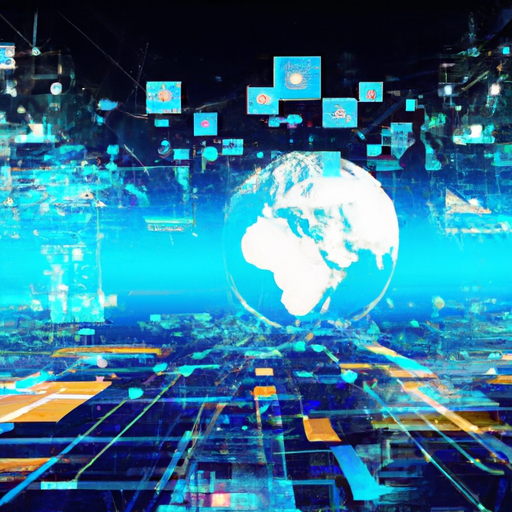What Are Some Emerging Trends In Information Technology?
In today’s ever-evolving world of technology, it’s essential to stay ahead of the game by keeping an eye on the emerging trends in information technology. From artificial intelligence to cloud computing and blockchain, there are rapid advancements that continue to reshape the IT landscape. This article explores some of the top emerging trends in information technology and how they are shaping the future of the industry. Whether you’re an IT professional or simply interested in staying up to date with the latest tech trends, this article will provide valuable insights into the exciting world of IT. So, buckle up and get ready to explore the fascinating realm of emerging trends in information technology!

Table of Contents
1. Cloud Computing
Cloud computing has revolutionized the way businesses store, access, and manage their data and applications. With the advancement of technology, several emerging trends have emerged in the field of cloud computing.
1.1 Edge Computing
Edge computing is a paradigm that brings the power of computation and data storage closer to the edge of the network, rather than relying solely on centralized cloud servers. This trend is gaining popularity due to the increasing number of internet-connected devices and the need for real-time processing and low latency applications. By processing data at the edge, businesses can reduce bandwidth usage, enhance security, and improve response times.
1.2 Multi-cloud Strategy
As organizations embrace the cloud, they are adopting a multi-cloud strategy. In this approach, companies distribute their workloads across multiple cloud platforms from different providers. By leveraging multiple cloud services, businesses can avoid vendor lock-in, optimize costs, and enhance flexibility and scalability. This trend allows organizations to choose the best services and solutions from multiple providers, providing increased resilience and redundancy.
1.3 Serverless Computing
Serverless computing, also known as Function as a Service (FaaS), allows developers to focus solely on writing the code for their applications without the need to manage and provision servers. In a serverless architecture, the cloud provider handles the infrastructure, auto-scaling, and availability, allowing developers to focus on their core application logic. This trend is revolutionizing application development by reducing complexity, costs, and time to market.
2. Artificial Intelligence (AI)
Artificial Intelligence has become an integral part of numerous industries, transforming the way businesses operate. There are several emerging trends within AI that are shaping the future of technology.
2.1 Machine Learning
Machine learning is a subfield of AI that enables systems to learn and improve from experience without explicit programming. This technology has been widely adopted in various domains, including healthcare, finance, and marketing. The advent of deep learning algorithms and neural networks has significantly enhanced the capabilities of machine learning, enabling applications such as image recognition, natural language understanding, and autonomous vehicles.
2.2 Natural Language Processing
Natural Language Processing (NLP) focuses on enabling computers to understand, interpret, and generate human language. With the advancements in NLP, machines can now comprehend and respond to human language, leading to the development of virtual assistants, chatbots, and voice-controlled devices. Companies are leveraging NLP to improve customer service, automate repetitive tasks, and extract valuable insights from large volumes of textual data.
2.3 Computer Vision
Computer Vision is an AI discipline that enables machines to analyze, interpret, and understand visual data. It has applications in various fields, including autonomous vehicles, surveillance, robotics, and augmented reality. Advancements in deep learning and neural networks have accelerated computer vision capabilities, allowing machines to accurately detect and recognize objects, scenes, and gestures. This technology is revolutionizing industries such as healthcare, agriculture, and manufacturing.
3. Internet of Things (IoT)
The Internet of Things (IoT) refers to the interconnected network of physical devices embedded with sensors, software, and connectivity that enables them to collect and exchange data. Several emerging trends within IoT are reshaping the way we interact with technology.
3.1 Industrial IoT
Industrial IoT focuses on the application of IoT technologies in industrial settings, such as manufacturing plants, energy grids, and transportation systems. By integrating sensors and devices, industries can monitor, analyze, and optimize their operations, leading to increased efficiency, reduced costs, and improved safety. Industrial IoT enables predictive maintenance, real-time monitoring, and automated workflows, transforming traditional industries into smart and connected ecosystems.
3.2 Smart Cities
A smart city utilizes IoT technologies to enhance the quality of life for its residents by optimizing urban services and infrastructure. By implementing IoT sensors, smart cities can collect real-time data on traffic, energy consumption, air quality, and waste management. This data enables city officials to make informed decisions and implement solutions that improve sustainability, efficiency, and livability. Smart cities enhance mobility, reduce pollution, and enable citizen engagement through the use of IoT technologies.
3.3 Wearable Devices
Wearable devices, such as smartwatches, fitness trackers, and augmented reality glasses, have gained significant popularity in recent years. These devices leverage IoT capabilities to collect and analyze user data, providing insights related to health, fitness, and productivity. Wearable devices can monitor vital signs, track physical activity, and provide real-time notifications and alerts. This emerging trend in IoT is transforming the healthcare industry, enabling remote patient monitoring, personalized medicine, and early disease detection.
4. Cybersecurity
As technology evolves, the need for robust cybersecurity measures becomes increasingly crucial. Several emerging trends in cybersecurity are aimed at enhancing protection against cyber threats and ensuring data privacy.
4.1 Zero Trust Architecture
Zero Trust Architecture is a security framework that assumes no trust in any user or device, regardless of their location. Instead of relying on perimeter-based security, Zero Trust Architecture focuses on verifying every user, device, and application before granting access to resources. By adopting a Zero Trust approach, organizations can mitigate the risk of data breaches, protect against insider threats, and enhance network security.
4.2 AI-powered Cybersecurity
Artificial Intelligence is being leveraged in cybersecurity to detect and respond to threats in real-time. AI-powered cybersecurity solutions can analyze vast amounts of data, identify patterns, and detect anomalies that indicate potential malicious activities. By employing machine learning algorithms, AI-powered cybersecurity systems can continuously adapt and improve their ability to identify and mitigate cyber threats. This emerging trend enhances the speed and accuracy of threat detection and response.
4.3 Endpoint Detection and Response (EDR)
Endpoint Detection and Response (EDR) is a cybersecurity technology that focuses on monitoring and responding to security incidents at the endpoint level. EDR solutions collect and analyze data from endpoints, such as laptops, smartphones, and servers, to detect and respond to potential security breaches. By monitoring endpoint activities, organizations can quickly identify and mitigate threats, prevent data loss, and ensure compliance with security policies.
5. Big Data Analytics
The exponential growth of data has given rise to the need for sophisticated analytics solutions. Big Data Analytics involves the process of analyzing large and complex datasets to extract valuable insights and drive informed decision-making. There are several emerging trends within Big Data Analytics that are transforming the way businesses leverage data.
5.1 Predictive Analytics
Predictive Analytics utilizes historical data, statistical algorithms, and machine learning techniques to forecast future outcomes. By analyzing patterns and trends in data, businesses can make accurate predictions about customer behavior, market trends, and operational efficiency. Predictive Analytics enables organizations to optimize marketing campaigns, reduce risks, and improve resource planning.
5.2 Prescriptive Analytics
Prescriptive Analytics goes beyond predicting future outcomes to provide insights on the best course of action. By leveraging advanced algorithms and optimization techniques, prescriptive analytics recommends optimal solutions to complex business problems. This emerging trend helps organizations make data-driven decisions, optimize processes, and improve overall business performance.
5.3 Real-time Analytics
Real-time Analytics focuses on analyzing data as it is generated, enabling businesses to make immediate decisions and take proactive actions. This trend is crucial in industries such as finance, e-commerce, and healthcare, where real-time insights drive competitive advantage. By analyzing streaming data, organizations can detect anomalies, identify trends, and respond to critical events in real-time.
6. Blockchain
Blockchain technology, initially associated with cryptocurrencies, has emerged as a disruptive force with applications beyond finance. The decentralized nature of blockchain enables secure, transparent, and tamper-proof transactions, leading to several emerging trends.
6.1 Decentralized Finance (DeFi)
Decentralized Finance, or DeFi, refers to the use of blockchain technology to recreate financial systems without traditional intermediaries. DeFi platforms enable activities such as lending, borrowing, and trading using cryptocurrency, eliminating the need for banks and brokers. This emerging trend in blockchain is revolutionizing the financial industry by providing greater accessibility, transparency, and efficiency.
6.2 Supply Chain Management
Blockchain technology is being adopted in supply chain management to enhance transparency, traceability, and security. By leveraging blockchain, companies can create immutable records of every transaction and movement within the supply chain, ensuring that all stakeholders have a clear view of the process. This trend enables better inventory management, reduces counterfeit products, and improves trust among supply chain partners.
6.3 Identity and Access Management
Blockchain-based Identity and Access Management systems offer a secure and decentralized solution for managing digital identities. By storing identity information on a blockchain, users have control over their personal data and can grant access to specific entities without relying on centralized authorities. This emerging trend enhances privacy, eliminates the risk of identity theft, and simplifies user authentication processes.
7. Augmented Reality (AR) and Virtual Reality (VR)
Augmented Reality (AR) and Virtual Reality (VR) technologies have gained significant attention in recent years due to their ability to enhance human experiences and interactions with the digital world. There are several emerging trends within AR and VR.
7.1 AR in Retail
AR is transforming the retail industry by enabling virtual try-ons, personalized shopping experiences, and enhanced product visualization. By overlaying digital information on the physical world, AR provides customers with interactive and immersive experiences, leading to increased customer engagement, reduced return rates, and improved sales conversion.
7.2 VR in Training and Simulation
VR technology is revolutionizing training and simulation by providing immersive and realistic environments for practice and skill development. Industries such as aviation, healthcare, and manufacturing are leveraging VR to train professionals in a safe and controlled environment. This emerging trend improves training effectiveness, reduces costs, and enhances safety by offering hands-on experiences in virtual settings.
7.3 Mixed Reality
Mixed Reality combines elements of both AR and VR to create immersive and interactive experiences. In mixed reality, virtual objects and digital information can interact with the physical world in real-time, enabling users to engage with their surroundings in a seamless manner. This trend has applications in various industries, including architecture, gaming, and education, where users can interact with virtual objects while maintaining a connection to the real world.
8. Quantum Computing
Quantum Computing is a highly advanced field of research that utilizes the principles of quantum mechanics to perform complex computations at an unprecedented speed. Although still in its early stages, several emerging trends in quantum computing are shaping the future of technology.
8.1 Quantum Supremacy
Quantum Supremacy refers to the point at which a quantum computer can perform a computation that is beyond the reach of classical computers. Achieving Quantum Supremacy holds significant implications for various industries, including cryptography, optimization, and drug discovery. This emerging trend in quantum computing marks a major milestone in the advancement of computing capabilities.
8.2 Quantum Cryptography
Quantum Cryptography aims to leverage the principles of quantum mechanics to enhance the security of communication networks. Unlike traditional encryption algorithms, quantum cryptography ensures secure transmission of data by utilizing the laws of quantum physics. This emerging trend in quantum computing has the potential to revolutionize data security by providing an unbreakable encryption method.
8.3 Quantum Machine Learning
Quantum Machine Learning combines the principles of quantum computing and machine learning to develop algorithms that can process and analyze vast amounts of data more efficiently. Quantum Machine Learning has the potential to solve complex optimization problems, accelerate data analysis, and improve prediction accuracy. This emerging trend in quantum computing opens up new possibilities for solving computationally intensive tasks.
9. Robotic Process Automation (RPA)
Robotic Process Automation (RPA) involves the use of software robots or “bots” to automate repetitive and rule-based tasks within business processes. This emerging trend in technology enables organizations to achieve operational efficiency, reduce costs, and improve accuracy.
9.1 Intelligent Process Automation
Intelligent Process Automation (IPA) combines RPA with Artificial Intelligence technologies to automate complex business processes that involve decision making and cognitive tasks. By integrating machine learning, natural language processing, and computer vision, IPA enables software bots to handle unstructured data, understand context, and make intelligent decisions. This emerging trend in RPA enhances automation capabilities and enables organizations to automate end-to-end processes.
9.2 Cognitive RPA
Cognitive RPA focuses on enhancing the cognitive abilities of software bots by incorporating capabilities such as natural language understanding, sentiment analysis, and decision-making. By leveraging cognitive technologies, software bots can interact with humans in a more human-like manner, perform complex tasks, and handle dynamic and unpredictable scenarios. This emerging trend in RPA enables organizations to automate complex cognitive processes, such as customer service and data analysis.
9.3 Unattended RPA
Unattended RPA involves the deployment of software bots that can operate autonomously without human intervention. These bots can execute tasks scheduled at predefined times or trigger-based events, working 24/7 without interruption. Unattended RPA enables organizations to achieve increased productivity, improve service levels, and reduce operational costs by automating processes that require minimal human involvement.
10. 5G Technology
5G technology is the next generation of wireless communication that promises faster speeds, lower latency, and greater connectivity. Several emerging trends within 5G technology are reshaping various industries.
10.1 Increased Bandwidth and Speed
One of the key benefits of 5G technology is the significant increase in bandwidth and speed compared to previous generations. With faster download and upload speeds, businesses can leverage bandwidth-intensive applications such as video streaming, virtual meetings, and cloud-based services. This emerging trend enables organizations to improve productivity, enhance user experiences, and support data-intensive technologies.
10.2 Low Latency Communication
5G technology offers significantly reduced latency, enabling near real-time communication between devices and applications. Low latency is crucial for applications such as autonomous vehicles, remote surgery, and industrial automation, where even a slight delay can have severe consequences. This emerging trend in 5G technology enables faster response times, enhances reliability, and opens up possibilities for innovative applications.
10.3 Smart Cities and Autonomous Vehicles
The implementation of 5G technology is transforming cities into smart environments and enabling the widespread adoption of autonomous vehicles. With its high capacity and low latency, 5G technology can support the massive data transfer requirements of interconnected devices in smart cities. Moreover, autonomous vehicles rely on real-time data communication for navigation and safety, which is made possible by the low latency and high-speed capabilities of 5G networks. This emerging trend revolutionizes urban mobility, enhances public services, and creates new business opportunities.
In conclusion, the field of Information Technology is constantly evolving, leading to several emerging trends that shape the future of technology. From cloud computing to quantum computing, each trend brings new opportunities and challenges for businesses and individuals. By staying abreast of these trends, organizations can harness the power of technology to transform their operations, improve efficiency, and drive innovation in their respective industries.






